Research on the Coupling Coordination of a Sea–Land System Based on an Integrated Approach and New Evaluation Index System: A Case Study in Hainan Province, China
Abstract
:1. Introduction
- (1)
- Comprehensive strategic objective. The ultimate goals of both approaches are to achieve the sustainable development of marine and coastal zones on the basis of a comprehensive consideration of the economic, environmental, social, and environmental needs.
- (2)
- Similarity of scope. They are both suitable for resource management of land and sea and the design of management mechanisms.
- (3)
- Diversification of means. They both emphasize the management of marine and coastal zones through policies, laws, regional planning, science and technology, education, training, and other means.
- (1)
- Focus. Sea–land coordination focuses on the characteristics of the marine system and the land system, and stresses the achievement of complementary advantages between the sea system and land system, two economic systems, through policy guidance and industry links. ICZM Manages and plans the development of coastal zones mainly based on natural, environmental, and social factors. It is more concerned about the ecological and environmental problems of the coastal zone, but it is less concerned about the development of the marine economy and coordination between the sea industry and land industry.
- (2)
- Viewing angle. Sea–land coordination solves the contradictions between sea system and land system from the perspective of the whole region. ICZM protects the environment and ecology of the coastal zone from the local perspective of the coastal zone.
- (3)
- Level. Sea–land coordination is a national strategy for the development of the sea economy and the land economy in China, and is a guiding ideology for planning and developing the marine and coastal economies. ICZM is a specific implementation process.
- (4)
- Scope of implementation. The spatial scope of sea–land coordination can not only cover marine and land areas, but also extend to international areas closely related to our interests. The spatial scope of the ICZM is a narrow strip.
2. Materials and Methods
2.1. Materials
2.1.1. Study Area
2.1.2. The Indexes System
2.2. Methods
2.2.1. Data Pre-Processing
2.2.2. Evaluation of the Statistical Data
2.2.3. Analysis of the Coupling Coordination Degree
The Coupling Coordination Degree Model (CCDM)
The Scissors Difference Model (SDM)
The Dynamic Coupling Coordination Degree Model (DCCDM)
3. Results and Discussion
3.1. The Time Series Analysis of the Comprehensive Evaluation Values of Sea System and Land System
3.2. The Time Series Analysis of Coupling Coordination Degree of Sea System and Land System
3.3. The Scissors Difference Analysis of Sea System and Land System
3.4. The Dynamic Coupling Coordination Degree Analysis of the Sea–Land System Model
3.5. The Influencing Factors of Coupling Coordination Degree of Sea System and Land System
4. Conclusions
- (1)
- From 1999 to 2013, the comprehensive evaluation values of the sea system and the land system of Hainan Province were basically increasing step by step, and the basic development trend was consistent. Moreover, the development of sea-land system in Hainan Province had gone through two stages from 1999–2013: the land economy dominant stage and the marine economy dominant stage.
- (2)
- Through the analysis of the coupling coordination degree between sea system and land system, it can be seen that the relationship between them is developing in a desirable way. This shows that under the influence of national policy, the government of Hainan has begun to pay attention to the land economy as well as to the marine economy and implemented the sea-land coordination policy.
- (3)
- With the attention of the country and the government of Hainan to the sea-land coordination policy, the gap between the development speed of the marine economy and land economy has been increasing, and the curve of the scissors difference is a “” type.
- (4)
- The dynamic coupling coordination degree of the sea–land system, which follows a parabolic curve, was basically in the break-in development stage from 1999–2013. At the same time, the coupling state of the sea–land system circled between the primary-grade coordinated development stage and the common development stage.
- (5)
- To promote coupling coordination development of sea–land system in Hainan Province, the government should give priority to economic development, social progress, and resource efficiency subsystems in adhering to the principles of developing the sea through science and technology and of sea–land coordination, and increase efforts towards and cultivate consciousness of environmental protection, making environmental protection an important aspect of promoting sea–land coordination. What’s more, improving the efficiency of economic development, increasing the investment in science and technology, labor and the infrastructure can effectively promote the coordinated development of sea–land system in Hainan.
Acknowledgments
Author Contributions
Conflicts of Interest
Appendix A
| Year | Gross Marine Product | GMP Accounts for GDP Proportion | Gross Fisheries Product | International Tourism Foreign Exchange Income | Main Port Cargo Throughput | Distribution of Coastal Observation | Staff and Workers of Marine Scientific Research | Number of Marine Science and Technology |
| 1999 | 0.000 | 0.000 | 0.000 | 0.061 | 0.000 | 0.0137 | 0.0000 | 0.0000 |
| 2000 | 0.019 | 0.103 | 0.066 | 0.062 | 0.020 | 0.0274 | 0.0108 | 0.0256 |
| 2001 | 0.057 | 0.342 | 0.126 | 0.063 | 0.033 | 0.0274 | 0.0216 | 0.0513 |
| 2002 | 0.066 | 0.307 | 0.116 | 0.024 | 0.060 | 0.0000 | 0.0270 | 0.0769 |
| 2003 | 0.110 | 0.495 | 0.167 | 0.000 | 0.097 | 0.3836 | 0.0054 | 0.0513 |
| 2004 | 0.200 | 0.851 | 0.232 | 0.038 | 0.123 | 0.4247 | 0.0162 | 0.0513 |
| 2005 | 0.237 | 0.874 | 0.307 | 0.190 | 0.134 | 0.3699 | 0.0108 | 0.1026 |
| 2006 | 0.310 | 0.981 | 0.187 | 0.524 | 0.345 | 0.2877 | 0.2595 | 0.3462 |
| 2007 | 0.382 | 1.000 | 0.255 | 0.777 | 0.512 | 0.3425 | 0.6649 | 0.4872 |
| 2008 | 0.452 | 0.944 | 0.344 | 0.826 | 0.544 | 0.3562 | 0.8324 | 0.4487 |
| 2009 | 0.505 | 0.946 | 0.415 | 0.572 | 0.602 | 0.2603 | 0.8757 | 0.5641 |
| 2010 | 0.610 | 0.864 | 0.507 | 0.768 | 0.718 | 0.5479 | 0.9027 | 0.6410 |
| 2011 | 0.723 | 0.797 | 0.657 | 1.000 | 0.829 | 0.3562 | 0.8378 | 1.0000 |
| 2012 | 0.842 | 0.822 | 0.810 | 0.829 | 0.910 | 0.0548 | 0.8757 | 0.5128 |
| 2013 | 1.000 | 0.917 | 1.000 | 0.831 | 1.000 | 1.0000 | 1.0000 | 0.5256 |
| Year | Direct Discharge of Industrial Waste Water into Marine | Number of Completed Projects for Marine Pollution Control in the Year | Number of Marine Nature Reserves | Per Capita Area of Marine Nature Reserves | Economic Density of Coastline | Length of Wharf | Marine Capture Production | Mariculture Area |
| 1999 | 0.390 | 0.108 | 0.708 | 0.007 | −0.001 | 0.000 | 0.000 | 0.393 |
| 2000 | 0.513 | 1.000 | 0.708 | 0.006 | 0.021 | 0.088 | 0.134 | 0.538 |
| 2001 | 0.661 | 0.324 | 0.708 | 0.006 | 0.043 | 0.088 | 0.275 | 0.670 |
| 2002 | 0.617 | 0.068 | 0.000 | 0.000 | 0.060 | 0.088 | 0.425 | 0.728 |
| 2003 | 1.000 | 0.135 | 0.000 | 0.000 | 0.027 | 0.088 | 0.588 | 0.761 |
| 2004 | 0.772 | 0.108 | 0.000 | 0.000 | 0.063 | 0.088 | 0.733 | 0.856 |
| 2005 | 0.444 | 0.324 | 0.167 | 0.005 | 0.108 | 0.176 | 0.870 | 0.894 |
| 2006 | 0.000 | 0.378 | 1.000 | 0.010 | 0.166 | 0.206 | 1.000 | 1.000 |
| 2007 | 0.332 | 0.216 | 1.000 | 0.010 | 0.229 | 0.243 | 0.606 | 0.000 |
| 2008 | 0.469 | 0.176 | 0.917 | 0.196 | 0.315 | 0.257 | 0.653 | 0.275 |
| 2009 | 0.814 | 0.068 | 1.000 | 0.010 | 0.421 | 0.727 | 0.825 | 0.610 |
| 2010 | 0.848 | 0.122 | 0.750 | 1.000 | 0.579 | 0.977 | 0.740 | 0.539 |
| 2011 | 0.436 | 0.311 | 0.750 | 0.184 | 0.756 | 0.977 | 0.824 | 0.550 |
| 2012 | 0.341 | 0.270 | 0.750 | 0.185 | 0.885 | 0.888 | 0.915 | 0.670 |
| 2013 | 0.376 | 0.000 | 0.750 | 0.183 | 0.997 | 1.000 | 0.933 | 0.764 |
| Year | Growth Rate of Gross National Product | Total Investment in Fixed Assets | Total Merchandise Exports in Foreign Trade | Total Retail Sales of Social Consumer Goods | Land Transportation Volume | Household Disposable Income of Urban Residents | Employee in Scientific Research and Technological Development | Financial Expenditure in Education, Health and Science |
| 1999 | 0.0000 | 0.000 | 0.000 | 0.000 | 0.094 | 0.000 | 0.105 | 0.000 |
| 2000 | 0.1590 | 0.001 | 0.018 | 0.018 | 0.084 | 0.001 | 0.153 | 0.005 |
| 2001 | 0.1240 | 0.006 | 0.018 | 0.037 | 0.030 | 0.028 | 0.200 | 0.013 |
| 2002 | 0.1880 | 0.014 | 0.024 | 0.057 | 0.000 | 0.084 | 0.000 | 0.026 |
| 2003 | 0.1650 | 0.034 | 0.041 | 0.042 | 0.068 | 0.109 | 0.013 | 0.034 |
| 2004 | 0.1710 | 0.053 | 0.116 | 0.097 | 0.117 | 0.136 | 0.097 | 0.051 |
| 2005 | 0.1410 | 0.075 | 0.093 | 0.139 | 0.184 | 0.158 | 0.285 | 0.081 |
| 2006 | 0.2760 | 0.093 | 0.239 | 0.191 | 0.323 | 0.231 | 0.310 | 0.102 |
| 2007 | 0.4120 | 0.126 | 0.368 | 0.262 | 0.430 | 0.322 | 0.297 | 0.177 |
| 2008 | 0.1180 | 0.205 | 0.377 | 0.375 | 0.310 | 0.413 | 0.387 | 0.272 |
| 2009 | 0.1290 | 0.320 | 0.389 | 0.467 | 0.304 | 0.478 | 0.478 | 0.403 |
| 2010 | 1.0000 | 0.450 | 0.555 | 0.573 | 0.611 | 0.582 | 0.745 | 0.522 |
| 2011 | 0.8470 | 0.561 | 0.606 | 0.717 | 0.743 | 0.741 | 0.804 | 0.716 |
| 2012 | 0.3180 | 0.771 | 0.809 | 0.853 | 0.901 | 0.886 | 0.902 | 0.890 |
| 2013 | 0.1410 | 1.000 | 1.000 | 1.000 | 1.000 | 1.000 | 1.000 | 1.000 |
| Year | Total Discharge of Industrial Waste Water | Industrial Solid Waste Generation | Pollution Control Project Investment | Afforested Area | Regional Economic Density | Per capita Arable Land | Total Energy Production | Percentage of Social Employed Population |
| 1999 | 0.963 | 1.000 | 0.002 | 0.072 | −0.001 | 0.984 | 0.000 | 0.009 |
| 2000 | 0.965 | 0.926 | 0.019 | 0.098 | 0.019 | 0.911 | 0.008 | 0.000 |
| 2001 | 0.967 | 0.984 | 0.000 | 0.383 | 0.040 | 0.779 | 0.012 | 0.000 |
| 2002 | 0.974 | 0.958 | 0.260 | 0.157 | 0.065 | 0.696 | 0.009 | 0.075 |
| 2003 | 0.961 | 0.938 | 0.004 | 1.000 | 0.081 | 0.576 | 0.006 | 0.129 |
| 2004 | 0.981 | 0.897 | 0.001 | 0.376 | 0.121 | 0.487 | 0.001 | 0.164 |
| 2005 | 0.961 | 0.835 | 0.091 | 0.329 | 0.159 | 0.401 | 0.010 | 0.185 |
| 2006 | 0.955 | 0.778 | 0.182 | 0.194 | 0.214 | 0.297 | 0.015 | 0.151 |
| 2007 | 1.000 | 0.747 | 0.008 | 0.029 | 0.285 | 0.190 | 0.020 | 0.248 |
| 2008 | 0.999 | 0.571 | 0.007 | 0.092 | 0.379 | 0.392 | 0.035 | 0.257 |
| 2009 | 0.966 | 0.625 | 0.007 | 0.125 | 0.436 | 0.293 | 0.039 | 0.340 |
| 2010 | 0.013 | 0.594 | 0.009 | 0.075 | 0.591 | 0.064 | 0.864 | 0.403 |
| 2011 | 0.044 | 0.000 | 1.000 | 0.072 | 0.764 | 0.071 | 0.957 | 0.523 |
| 2012 | 0.000 | 0.099 | 0.162 | 0.047 | 0.890 | 0.043 | 1.000 | 0.766 |
| 2013 | 0.029 | 0.040 | 0.051 | 0.000 | 1.000 | 0.004 | 0.898 | 1.000 |
References
- Pajaro, M.G.; Mulrennan, M.E.; Vincent, A.C.J. Toward an integrated marine protected areas policy: Connecting the global to the local. Environ. Dev. Sustain. 2010, 12, 945–965. [Google Scholar] [CrossRef]
- Smith, H.D. The industrialization of the world ocean. Ocean Coast. Manag. 2000, 43, 11–28. [Google Scholar] [CrossRef]
- Theory and Practice. Decision of the Central Committee of the Communist Party of China on Several Issues of Perfecting the Socialist Mark Economic System; People’s Publishing House: Beijing, China, 2003. (In Chinese) [Google Scholar]
- Xi, J.P. A note on the proposal of the CPC Central Committee on the formulation of the thirteenth five-year plan for national economic and social development. Pract. Theory Thought 2015, 11, 24–31. (In Chinese) [Google Scholar]
- Zhang, H.F. A discussion on the integration of sea-land co-planning to build a powerful country. Pac. J. 2005, 7, 14–17, (In Chinese with English Abstract). [Google Scholar]
- Cincin-Sain, B.; Belfiore, S. Linking marine protected areas to integrate coastal and ocean management: A review of theory and practice. Ocean Coast. Manag. 2005, 48, 847–868. [Google Scholar] [CrossRef]
- Panayotou, K. Coastal management and climate change: an Australian perspective. J. Coast. Res. 2009, 1, 742–746. [Google Scholar]
- Mitchell, C.L. Sustainable oceans development: The Canadian approach. Mar. Policy 1998, 22, 393–412. [Google Scholar] [CrossRef]
- Han, Z.L.; Di, Q.B.; Zhou, L.P. Discussion on the connotation and target of sea–land coordination. Mar. Econ. 2012, 1, 10–15, (In Chinese with English Abstract). [Google Scholar]
- Ye, X.D. Constructing “Digital Ocean” to implement sea–land coordination. Pac. J. 2007, 4, 77–86. (In Chinese) [Google Scholar]
- Wang, L. Achievements, problems and prospects of land and sea-land co-ordination development. Macroecon. Manag. 2013, 9, 23–24. (In Chinese) [Google Scholar]
- Yang, Y.D.; Sun, C.Z. Assessment of land-sea coordination in the Bohai sea ring area and spatial-temporal differences. Resour. Sci. 2014, 4, 691–701, (In Chinese with English Abstract). [Google Scholar]
- Sun, C.Z.; Gao, Y.; Han, J. Sea & land economy integration assessment based on competence structure relation model in the Bohai Sea ring area. Areal Res. Dev. 2012, 12, 28–33, (In Chinese with English Abstract). [Google Scholar]
- Liang, J.J.; Yang, M.Z. Analyzing and evaluating Guangdong’s coupling coordination and evolution of the land-sea system. Mar. Econ. 2015, 8, 42–48, (In Chinese with English Abstract). [Google Scholar]
- Zhao, X.; Nan, X. A study of the coupling coordination mechanism between marine and land economy from the perspective of the giant system. Ecol. Econ. 2016, 8, 25–35. [Google Scholar]
- Fan, F.; Sun, C.Z. Research on the cooperation development of marine & inland economy in Liaoning Province. Areal Res. Dev. 2011, 2, 59–63, (In Chinese with English Abstract). [Google Scholar]
- Jiang, B.G.; Han, L.M. Strategies for building Shandong Peninsula Blue Economic Zone. J. Shandong Univ. 2009, 5, 92–96, (In Chinese with English Abstract). [Google Scholar]
- Chang, Y.M.; Cheng, C.C. Spatial-temporal evolution of regional economic pattern in Anhui Province. Areal Res. Dev. 2012, 4, 34–36, (In Chinese with English Abstract). [Google Scholar]
- Ye, B.; Li, J.Q. Studies on the optimizing strategy of the structure of marine industry in Hainan. J. Huazhong Normal Univ. 2011, 45, 125–128, (In Chinese with English Abstract). [Google Scholar]
- Wu, R.; Wang, D.U. Analysis of marine ecology and environmental protection in Hainan. Ocean Dev. Manag. 2013, 9, 61–65. (In Chinese) [Google Scholar]
- Zhang, G.H.; Wang, J. Ecological risk assessment and early warning mechanism for tourism development in Hainan Province. Trop. Geogr. 2013, 1, 88–95, (In Chinese with English Abstract). [Google Scholar]
- Yang, W. Administrative arrangements and displacement compensation in top-down tourism planning—A case from Hainan Province, China. Tour. Manag. 2007, 28, 70–82. [Google Scholar]
- Pittman, J.; Armitage, D. Governance across the land-sea interface: A systematic review. Environ. Sci. Policy 2016, 64, 9–17. [Google Scholar] [CrossRef]
- Li, M.; Jin, F.; Song, Z.; Liu, Y. Spatial coupling analysis of regional economic development and environmental pollution in China. J. Geogr. Sci. 2013, 23, 525–537. [Google Scholar]
- Wang, Q.; Yang, Y. The research of marine economy and land economy overall planning based on symbiosis theory. Chin. Fish. Econ. 2016, 5, 26–34, (In Chinese with English Abstract). [Google Scholar]
- Liu, X.M.; Zhang, Y.N.; Fan, L. A study on the influential factors of the overall development of marine & land economy of Shandong Province. Technol. Innov. Manag. 2017, 2, 136–144, (In Chinese with English Abstract). [Google Scholar]
- Gai, M.; Liu, W.; Tian, C. Spatial-temporal coupling on marine and land industrial systems in coastal regions of China. Resour. Sci. 2013, 35, 966–976, (In Chinese with English Abstract). [Google Scholar]
- Ding, L.; Zhao, W.; Huang, Y.; Cheng, S. Research on the Coupling Coordination Relationship between urbanization and the air environment: A case study of the area of Wuhan. Atmosphere 2015, 6, 1539–1558. [Google Scholar] [CrossRef]
- Ai, J.Y.; Feng, L.; Dong, X.W.; Zhu, X.D. Exploring coupling coordination between urbanization and ecosystem quality (1985–2010): A case study from Lianyungang City, China. Front. Earth Sci. 2016, 10, 527–545. [Google Scholar] [CrossRef]
- Wang, S.J.; Ma, H.T.; Zhao, Y.B. Exploring the relationship between urbanization and the Eco-environment—A case study of Beijing-Tianjin-Hebei region. Ecol. Indic. 2014, 45, 171–183. [Google Scholar] [CrossRef]
- Ishizaka, A.; Labib, A. Review of the main developments of the analytic hierarchy process. Expert Syst. Appl. 2011, 39, 14336–14345. [Google Scholar] [CrossRef]
- Stefanidis, S.; Stathis, D.R. Assessment of flood hazard based on natural and anthropocentric factors using analytic hierarchy process (AHP). Nat. Hazards 2013, 68, 569–585. [Google Scholar] [CrossRef]
- Yan, J.H.; Feng, C.H.; Li, L. Sustainability assessment of machining process based on extension theory and entropy weight approach. Int. J. Adv. Manuf. Technol. 2014, 71, 1419–1431. [Google Scholar] [CrossRef]
- Jesmin, F.K.; Sharif, M.B. Weighted entropy for segmentation evaluation. Opt. Laser Technol. 2014, 57, 236–242. [Google Scholar]
- Lai, C.; Chen, X.; Wang, Z.; Wu, X. A fuzzy comprehensive evaluation model for flood risk based on the combination weight of game theory. Nat. Hazards 2015, 77, 1243–1259. [Google Scholar] [CrossRef]
- Liao, C.B. Quantitative judgment and classification system for coordinated development of environment an economy. Top. Geogr. 1999, 2, 171–177, (In Chinese with English Abstract). [Google Scholar]
- Zhou, Z.L.; Cao, Q.Q. Coupling coordination degree model of oil-economy-environment system in the western region. In Proceedings of the 2014 International Conference on Management Science and Engineering, Helsinki, Finland, 17–19 August 2014; IEEE: New York, NY, USA, 2014; pp. 827–832. [Google Scholar]
- Zhou, D.; Xu, J.; Lin, Z. Conflict or coordination? Assessing land use multi-functionalization using production-living-ecology analysis. Sci. Total Environ. 2016, 577, 136–147. [Google Scholar] [CrossRef] [PubMed]
- Li, Q.; Su, Y.; Pei, Y. Research on coupling coordination degree model between upstream and downstream enterprises. In Proceedings of the 2008 International Conference on Information Management, Innovation Management and Industrial Engineering, Taipei, Taiwan, 19–21 December 2008. [Google Scholar] [CrossRef]
- Tang, Z. An integrated approach to evaluating the coupling coordination between tourism and the environment. Tour. Manag. 2015, 46, 11–19. [Google Scholar] [CrossRef]
- Yuan, Y.Q.; Jin, M.Z.; Ren, J.F.; Hu, M.; Ren, P.Y. The dynamic coordinated development of a regional environment-tourism-economy system: A case study from western Hunan Province, China. Sustainability 2014, 6, 5231–5251. [Google Scholar] [CrossRef]
- Seton, F. Scissor crises, value-prices, and the movement of value-prices under technical change. Struct. Chang. Econ. Dyn. 2000, 11, 13–24. [Google Scholar] [CrossRef]
- Yue, D.; Xu, X.; Li, Z.; Hui, C.; Li, W.; Yang, H.; Ge, J. Spatiotemporal analysis of ecological footprint and biological capacity of Gansu, China 1991–2015: Down from the environmental cliff. Ecol. Econ. 2006, 58, 393–406. [Google Scholar] [CrossRef]
- Li, X.J.; Tao, J.G. The dynamic coupling analysis for coordinated development of the environment and economy based on cloud model: Case study of Henan. In Proceedings of the 2014 International Conference on Management Science & Engineering, Helsinki, Finland, 17–19 August 2014; IEEE: New York, NY, USA, 2014; pp. 726–735. [Google Scholar]
- Li, C.M. Study of coordinated development model and its application between the economy and resources environment in small town. Syst. Eng. Theory Pract. 2004, 11, 134–144, (In Chinese with English Abstract). [Google Scholar]
- Wang, Z.K. The state council approved the implementation of the “National Marine Economic Development Plan“. Mar. Inf. 2003, 3, 31. [Google Scholar]
- Zhao, Y.; Wang, S.; Zhou, C. Understanding the relation between urbanization and the eco-environment in China’s Yangtze River Delta using an improved EKC model and coupling analysis. Sci. Total Environ. 2016, 571, 862–875. [Google Scholar] [CrossRef] [PubMed]
- Ioppolo, G.; Saija, G.; Salomone, R. From coastal management to environmental management: The sustainable eco-tourism program for the mid-western coast of Sardinia. Land Use Policy 2013, 31, 460–471. [Google Scholar] [CrossRef]
- Marotta, L.; Ceccaroni, L.; Matteucci, G.; Rossini, P.; Guerzoni, P. A decision-support system in ICZM for protecting the ecosystems: Integration with the habitat directive. J. Coast. Conserv. 2011, 15, 393–405. [Google Scholar] [CrossRef]
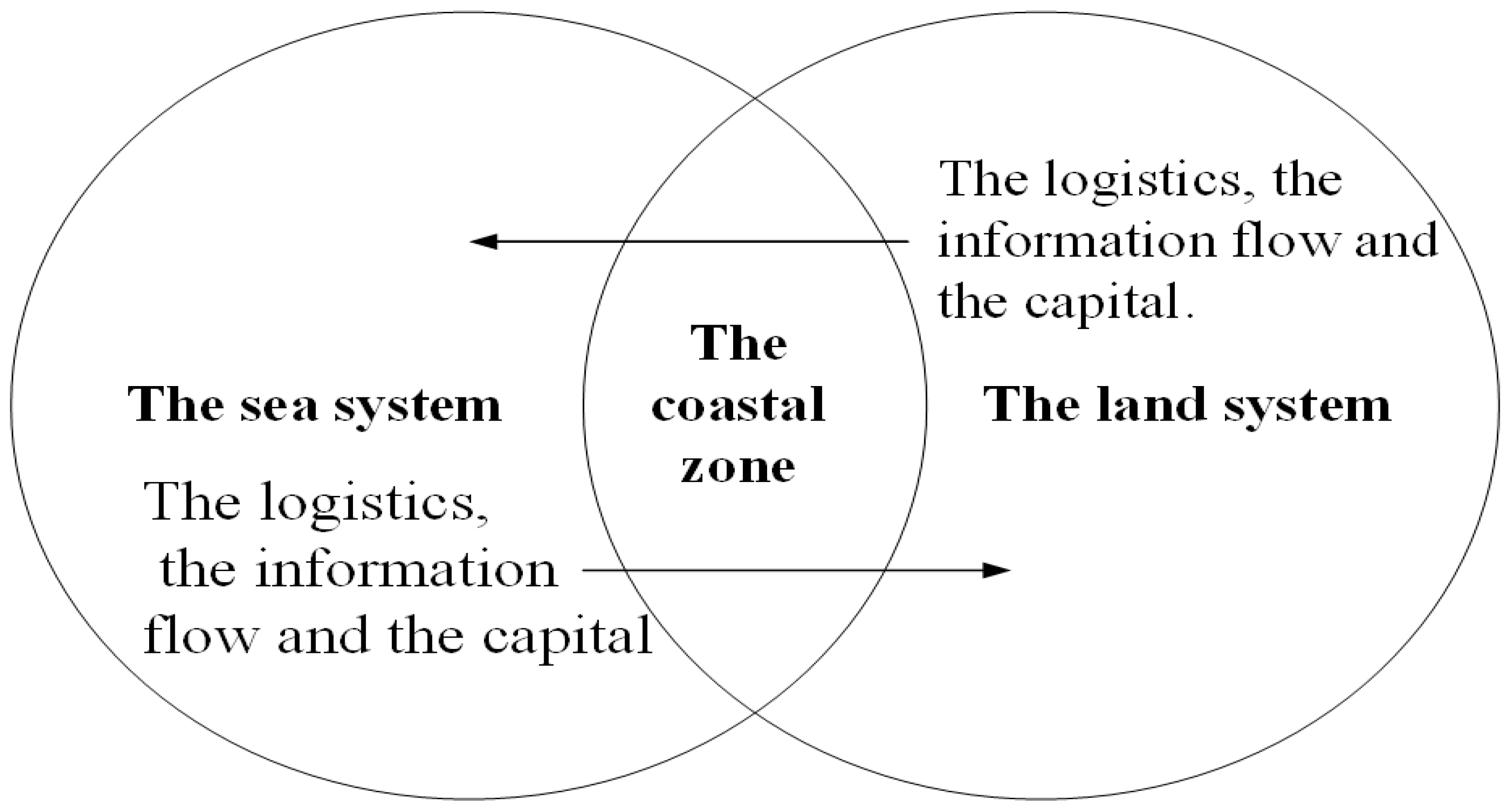
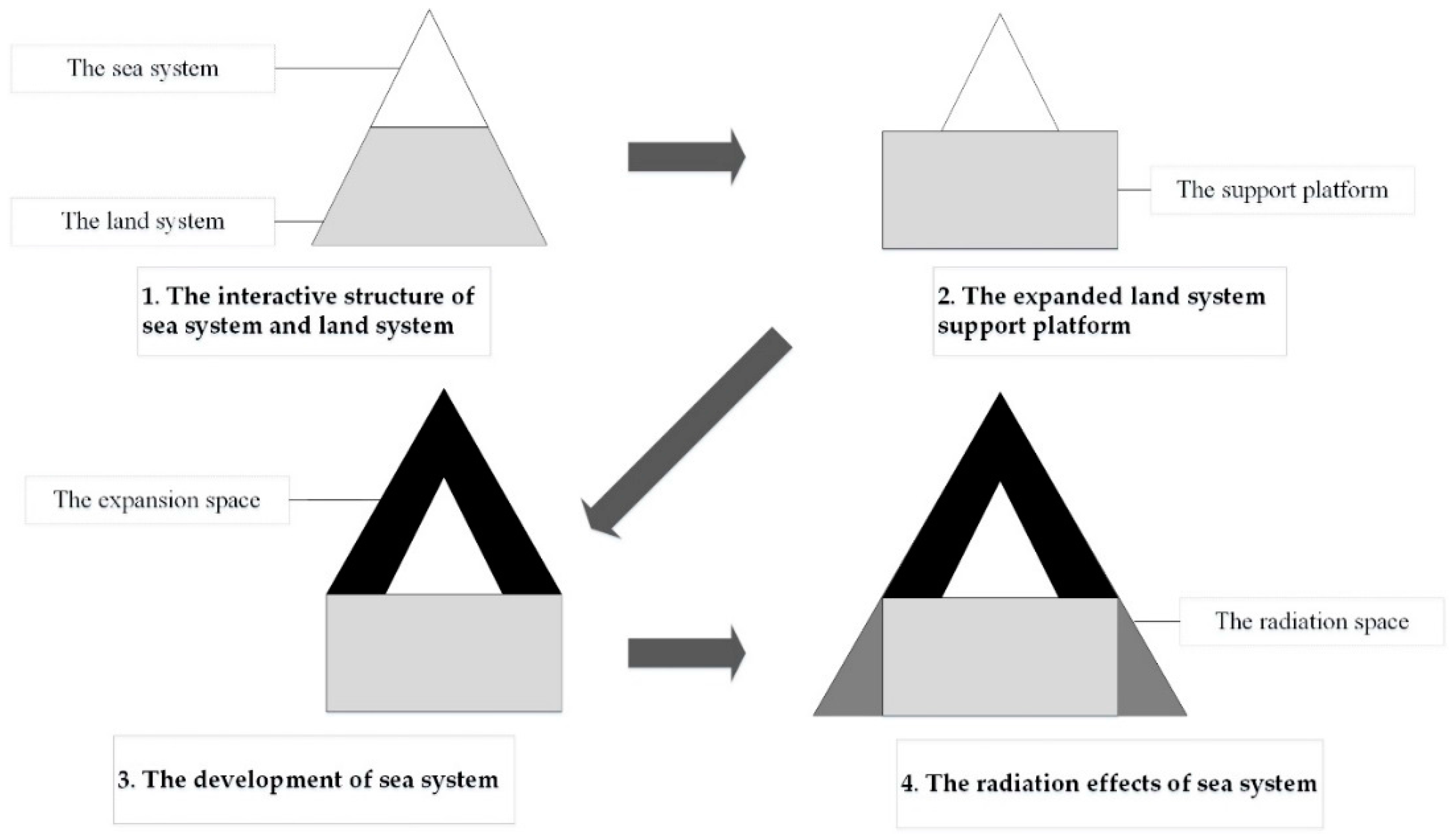
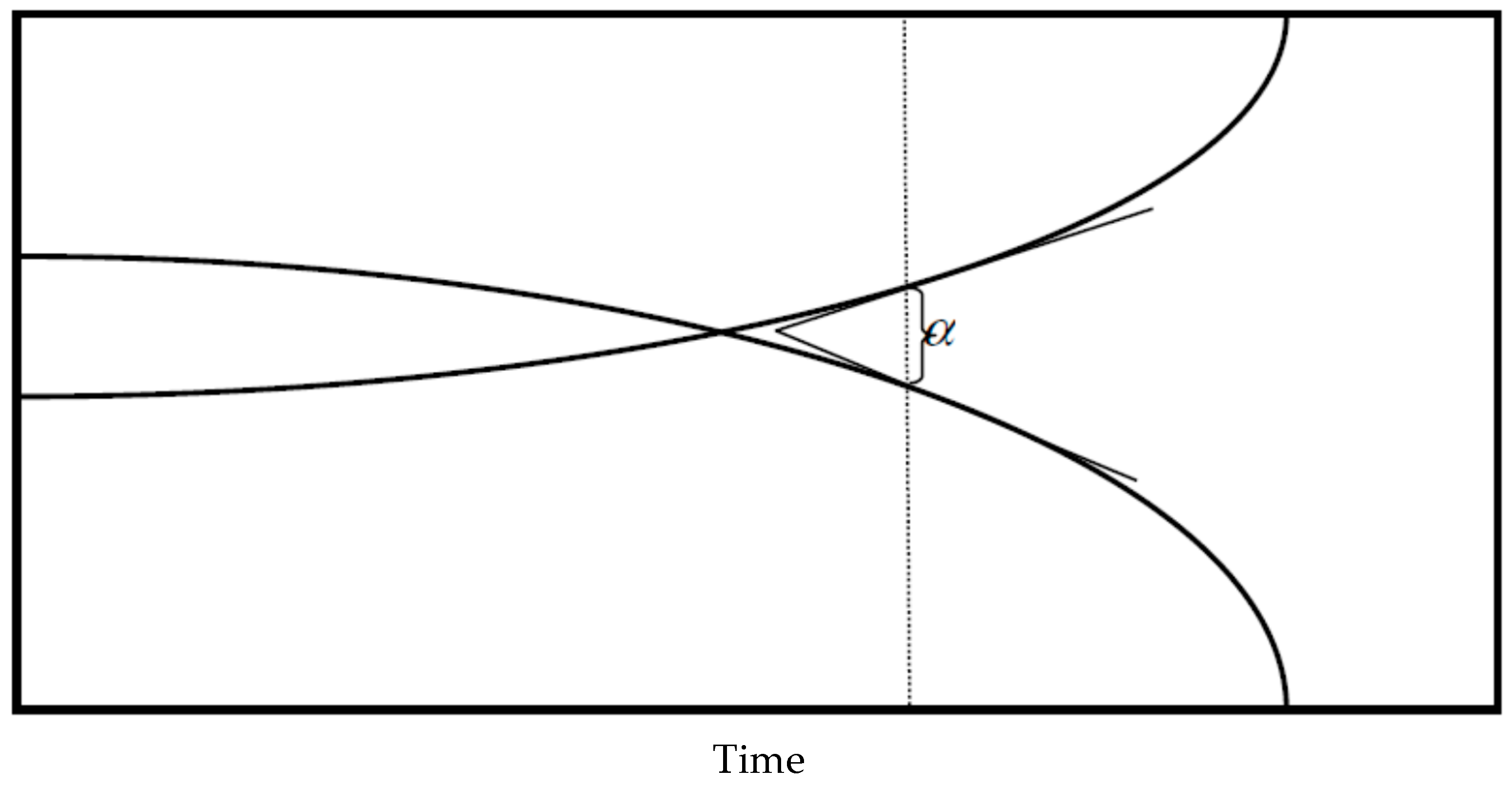
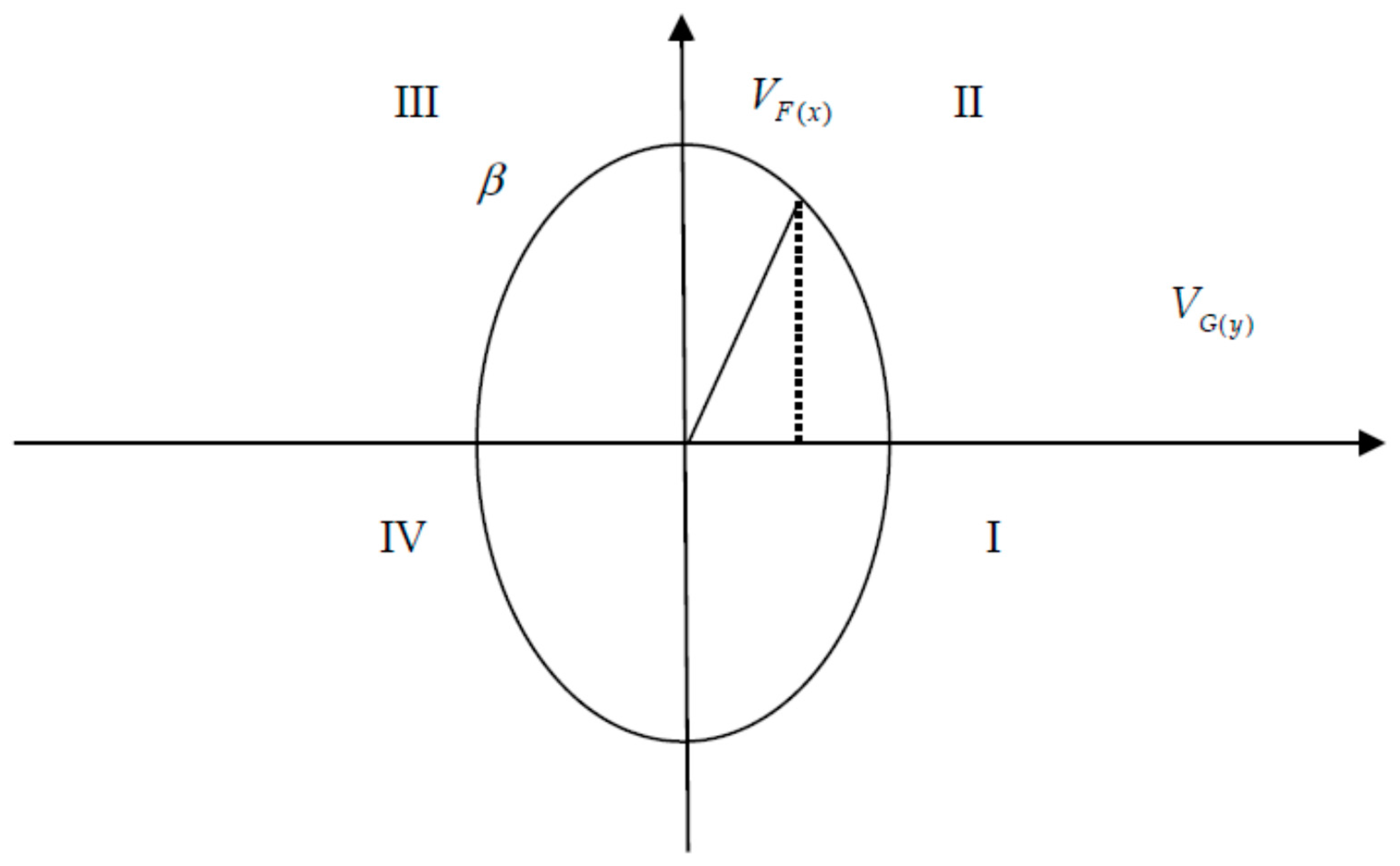
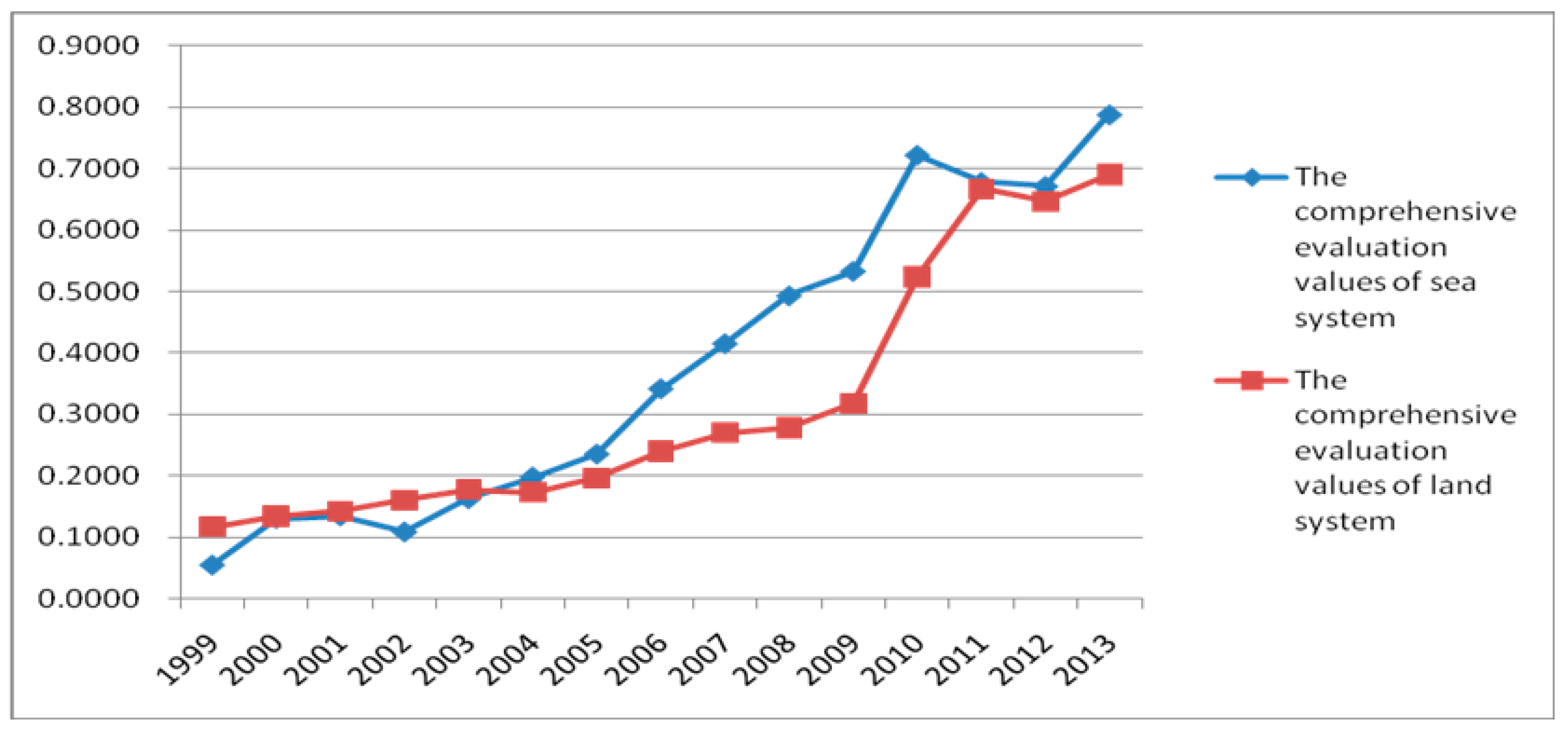
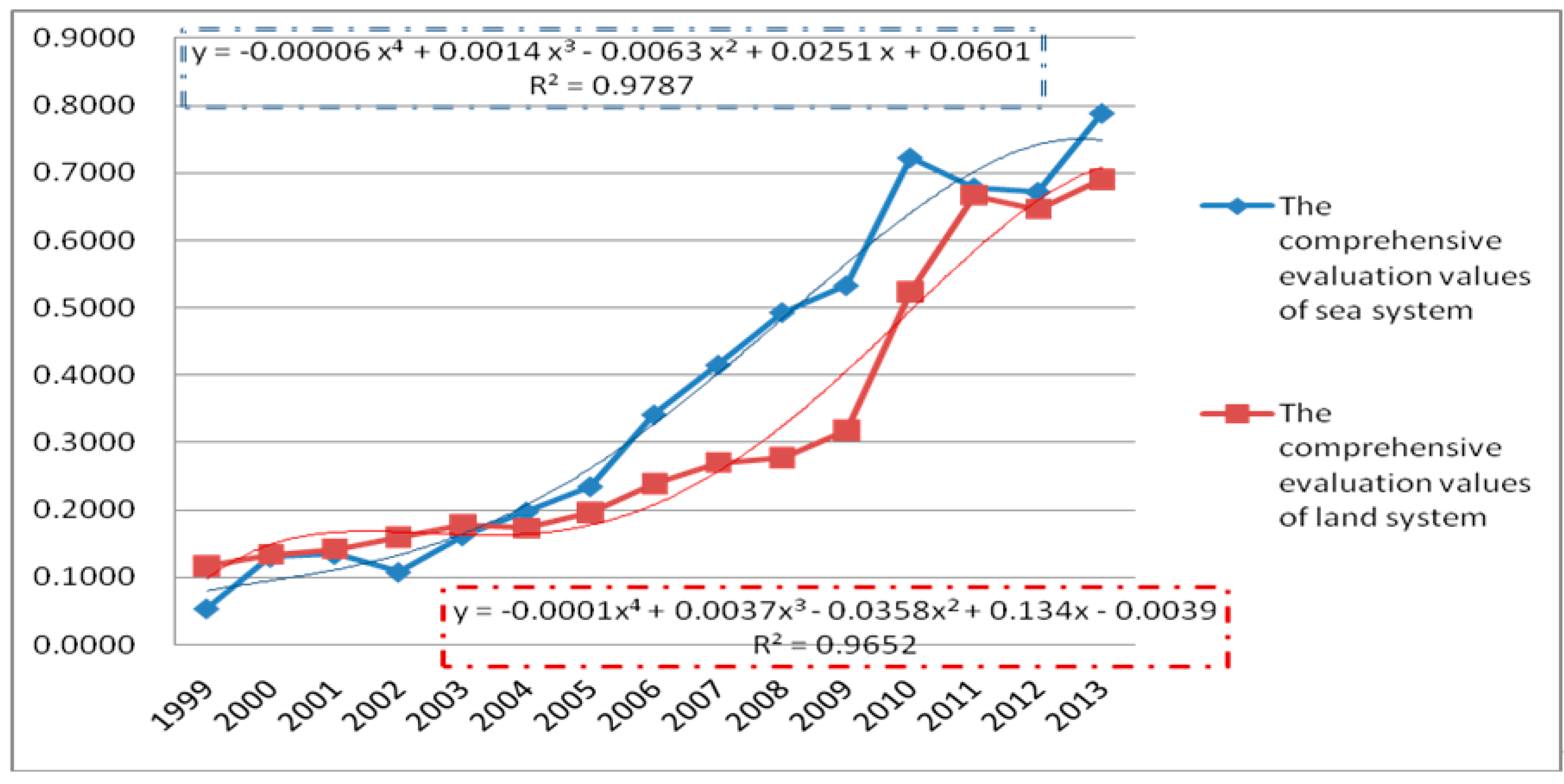

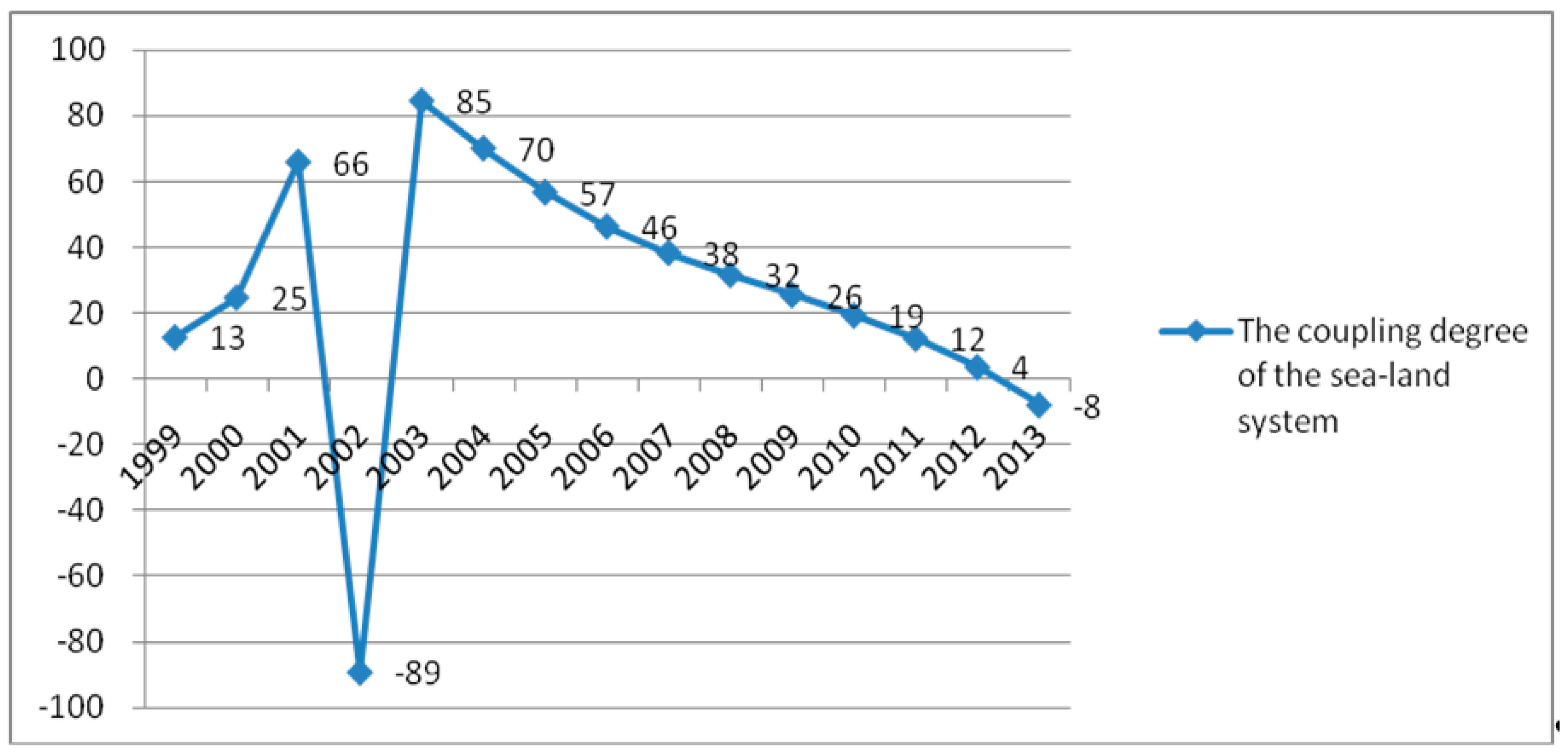
| The Advantages and Disadvantages of Developing Sea–Land Coordination in China | |
| The advantages | 1. The rapid development of the marine economy has laid a solid material foundation for the implementation of sea–land coordination. |
| 2. The Chinese government attaches great importance to sea–land coordination, and has upgraded sea–land coordination to a national strategy. | |
| 3. In academic circles, the research on the sea–land coordination has made some achievements, which provides a theoretical guidance for the sea–land coordination. 4. The main adviser of the sea-land coordination policy is the Chinese government, which provides an effective guarantee for the smooth implementation of this policy. | |
| The disadvantages | 1. The coordination between governments at all levels is difficult. |
| 2. Disputes over the maritime boundaries have affected the process of the sea–land coordination internationally. | |
| 3. Due to historical reasons and lack of publicity, at present the concept of “heavy land light sea” is serious, and the national awareness of developing the sea economy is weak. | |
| 4. The legal system of sea–land coordination has not yet formed. | |
| The advantages and disadvantages of ICZM | |
| The advantages | 1. At present, there are many achievements in the ICZM at home and abroad, which lay a solid foundation for the future research. 2. The dynamic assessment of the ICZM has formed a mature index assessment system, which can be expressed specifically as DPSIR model (drive-pressure-status-influence-reaction). 3. A variety of new technologies or methods have been routinely used in the ICZM research, such as Geographic Information System (GIS), Remote sensing, Decision Support Systems, Visual database, Ocean Geographic Techniques and so on. |
| The disadvantages | 1. At present, there is no uniform definition of the coastal zone at home and abroad, so the scope of ICZM cannot be well defined, leading to legislative difficulties in the coastal zone. 2. The main disciplines of ICZM research are distributed in the fields of environmental science, ecology, oceanography, geography and other natural sciences, and the social science research is less; it mainly focuses on the international relations law. 3. The funding support to ICZM is less; much of the funding comes from the international organizations. 4. The ICZM focuses on the planning process, the evaluation of the effect after the implementation of ICZM is insufficient, leading experience of ICZM cannot be well studied. |
| System Grade | Subsystem Grade | Basic Grade | |||
|---|---|---|---|---|---|
| Sea System | Economic development | X1: Gross Marine Product (100 million CNY) | 0.1294 | 0.0568 | 0.0884 |
| X2: GMP accounts for GDP proportion (%) | 0.0458 | 0.0245 | 0.0337 | ||
| X3: Gross fisheries product (100 million CNY) | 0.0915 | 0.0474 | 0.0664 | ||
| X4: International tourism foreign exchange income (USD 10,000) | 0.0647 | 0.0655 | 0.0644 | ||
| Social progress | X5: Main port cargo throughput (10,000 tons) | 0.0901 | 0.0652 | 0.0755 | |
| X6: Distribution of coastal observation stations (number) | 0.0576 | 0.0594 | 0.0579 | ||
| X7: Staff and workers of marine scientific research (person) | 0.1275 | 0.1526 | 0.1398 | ||
| X8: Number of marine science and technology (number) | 0.0332 | 0.0489 | 0.0414 | ||
| Environmental protection | X9: Direct discharge of industrial waste water into marine (million tons) | 0.0520 | 0.0199 | 0.0339 | |
| X10: Number of completed projects for marine pollution control in the year (unit) | 0.0368 | 0.0551 | 0.0464 | ||
| X11: Number of marine nature reserves (unit) | 0.0136 | 0.0412 | 0.0285 | ||
| X12: Per capita area of marine nature reserves (m2) | 0.0235 | 0.1925 | 0.1154 | ||
| Resource efficiency | X13: Economic density of coastline (100 million CNY/km) | 0.0975 | 0.0823 | 0.0881 | |
| X14: Length of wharf (m) | 0.0281 | 0.0699 | 0.0506 | ||
| X15: Marine capture production (tons) | 0.0689 | 0.0223 | 0.0427 | ||
| X16: Mariculture area (hm2) | 0.0398 | 0.0169 | 0.0269 | ||
| Land System | Economic development | X17: Growth rate of gross national product (%) | 0.1370 | 0.0442 | 0.0858 |
| X18: Total investment in fixed assets (100 million CNY) | 0.0619 | 0.0807 | 0.0723 | ||
| X19: Total merchandise exports in foreign trade (ten thousand US dollars) | 0.0357 | 0.0594 | 0.0488 | ||
| X20: Total retail sales of social consumer goods (10 thousand CNY) | 0.0968 | 0.0580 | 0.0754 | ||
| Social progress | X21: Land transportation volume (10,000 tons) | 0.1283 | 0.0485 | 0.0843 | |
| X22: Household disposable income of urban residents (CNY) | 0.0907 | 0.0524 | 0.0696 | ||
| X23: Employee in scientific research and technological development (person) | 0.0370 | 0.0424 | 0.0400 | ||
| X24: Financial expenditure in education, health and science (10 thousand CNY) | 0.0524 | 0.0756 | 0.0652 | ||
| Environmental protection | X25: Total discharge of industrial waste water (10,000 tons) | 0.0434 | 0.0321 | 0.0372 | |
| X26: Industrial solid waste generation (10,000 tons) | 0.0480 | 0.0226 | 0.0340 | ||
| X27: Pollution control project investment (million CNY) | 0.0211 | 0.1444 | 0.0891 | ||
| X28: Afforested area (ha.) | 0.0135 | 0.0621 | 0.0403 | ||
| Resource efficiency | X29: Regional economic density (100 million CNY/km2) | 0.0968 | 0.0539 | 0.0731 | |
| X30: Per capita arable land(hm2) | 0.0253 | 0.0373 | 0.0319 | ||
| X31: Total energy production (10,000 tons of standard coal) | 0.0685 | 0.1319 | 0.1035 | ||
| X32: Percentage of social employed population (%) | 0.0438 | 0.0547 | 0.0498 |
| Section | Value | Types |
|---|---|---|
| Uncoordinated Development | 0~0.09 | Extremely uncoordinated |
| 0.10~0.19 | Seriously uncoordinated | |
| 0.20~0.29 | Moderately uncoordinated | |
| 0.30~0.39 | Slightly uncoordinated | |
| Transitional Development | 0.40~0.49 | On the verge of uncoordinated |
| 0.50~0.59 | Barely coordinated | |
| Coordinated Development | 0.60~0.69 | Slightly coordinated |
| 0.70~0.79 | Moderately coordinated | |
| 0.80~0.89 | Well coordinated | |
| 0.90~1.00 | Quality coordinated |
| The Range of | Stage | Development Stage | The Performance |
|---|---|---|---|
| I | low-grade symbiosis stage | During this period, the development speed of sea system is slow, and it is not restricted by land system. The impact of the sea system on the land system is almost zero. | |
| II | primary-grade coordinated development stage | , the development speed of the sea system is less than that of the land system, and the sea system has already begun to show the stress on the land system. | |
| harmonious development stage | , the development speed of the sea system is equal to that of the land system. It is harmonious between the sea system and the land system. | ||
| common development stage | , with the rapid development of the sea system, the two system began to interact with each other, and the restriction of the land system to the sea system began to appear, but it is not prominent. | ||
| III | utmost development stage | With the rapid development of the marine economy, the sea system has accelerated the demand for land resources, the contradiction between the sea system and the land system has become increasingly prominent, which has restricted the development of the marine economy. | |
| IV | high-grade symbiosis stage | The restriction between the sea system and the land system has been gradually transformed into mutual promotion, and finally reaches a high-grate symbiosis between the sea system and the land system. |
| Year | The Comprehensive Evaluation Values of Sea System () | The Comprehensive Evaluation Values of Land System () |
|---|---|---|
| 1999 | 0.0544 | 0.1169 |
| 2000 | 0.1304 | 0.1339 |
| 2001 | 0.1346 | 0.1419 |
| 2002 | 0.1084 | 0.1601 |
| 2003 | 0.1625 | 0.1775 |
| 2004 | 0.1980 | 0.1730 |
| 2005 | 0.2354 | 0.1959 |
| 2006 | 0.3418 | 0.2391 |
| 2007 | 0.4153 | 0.2700 |
| 2008 | 0.4933 | 0.2774 |
| 2009 | 0.5331 | 0.3177 |
| 2010 | 0.7225 | 0.5238 |
| 2011 | 0.6783 | 0.6667 |
| 2012 | 0.6717 | 0.6464 |
| 2013 | 0.7883 | 0.6906 |
| Year | Coupling Degree | Coupling Coordination Degree | Grade of Coupling Coordination |
|---|---|---|---|
| 1999 | 0.9310 | 0.2824 | Moderately uncoordinated |
| 2000 | 0.9999 | 0.3635 | Slightly uncoordinated |
| 2001 | 0.9997 | 0.3718 | Slightly uncoordinated |
| 2002 | 0.9813 | 0.3630 | Slightly uncoordinated |
| 2003 | 0.9990 | 0.4121 | On the verge of uncoordinated |
| 2004 | 0.9977 | 0.4302 | On the verge of uncoordinated |
| 2005 | 0.9958 | 0.4634 | On the verge of uncoordinated |
| 2006 | 0.9842 | 0.5347 | Barely coordinated |
| 2007 | 0.9773 | 0.5787 | Barely coordinated |
| 2008 | 0.9599 | 0.6082 | Slightly coordinated |
| 2009 | 0.9674 | 0.6415 | Slightly coordinated |
| 2010 | 0.9872 | 0.7843 | Moderately coordinated |
| 2011 | 1.0000 | 0.8200 | Well coordinated |
| 2012 | 0.9998 | 0.8117 | Well coordinated |
| 2013 | 0.9978 | 0.8590 | Well coordinated |
| Model Summary | ||||||||||
|---|---|---|---|---|---|---|---|---|---|---|
| Model | R | R2 | Adjusted R2 | Standard Estimation Error | Change the Statistics | Durbin–Watson | ||||
| R2 Changes | F Changes | df1 | df2 | Sig. F Changes | ||||||
| 1 | 0.996 a | 0.993 b | 0.992 | 0.0176638 | 0.993 | 824.459 | 2 | 12 | 0.000 | 0.979 |
| Coefficient | |||||||
|---|---|---|---|---|---|---|---|
| Model | Non-Normalized Coefficients | Normalized Coefficients | t | Sig. | The Colinearity Statistics | ||
| B | Normalized Error | Trial Version | Tolerance | VIF | |||
| constant a | 0.265 | 0.009 | 31.005 | 0.000 | |||
| the comprehensive evaluation values of sea system a | 0.582 | 0.052 | 0.767 | 11.079 | 0.000 | 0.126 | 7.955 |
| the comprehensive evaluation values of land system a The coupling coordination degree D b | 0.223 | 0.064 | 0.242 | 3.492 | 0.004 | 0.126 | 7.955 |
| System Grade | Influencing Factor | The Linear Regression Equation | The Fitting Degree | Influence Order |
|---|---|---|---|---|
| The sea system | Economic Development | 0.966 | 2 | |
| Social Progress | 0.933 | 3 | ||
| Environmental Protection | 0.244 | |||
| Resource Efficiency | 0.919 | 1 | ||
| The land system | Economic Development | 0.953 | 1 | |
| Social Progress | 0.092 | 3 | ||
| Environmental Protection | 0.484 | |||
| Resource Efficiency | 0.814 | 2 |
| Index Evaluation System | Influence Order | Index Evaluation System | Influence Order |
|---|---|---|---|
| X1: Gross Marine Product (100 million CNY) | 10 | X17: Growth rate of gross national product (%) | 5 |
| X2: GMP accounts for GDP proportion (%) | 2 | X18: Total investment in fixed assets (100 million CNY) | 2 |
| X3: Gross fisheries product (100 million CNY) | 4 | X19: Total merchandise exports in foreign trade (ten thousand US dollars) | 11 |
| X4: International tourism foreign exchange income (USD 10,000) | 8 | X20: Total retail sales of social consumer goods (10 thousand CNY) | 10 |
| X5: Main port cargo throughput (10,000 tons) | 9 | X21: Land transportation volume (10,000 tons) | 12 |
| X6: Distribution of coastal observation stations (number) | 7 | X22: Household disposable income of urban residents (CNY) | 8 |
| X7: Staff and workers of marine scientific research (person) | 15 | X23: Employee in scientific research and technological development (person) | 15 |
| X8: Number of marine science and technology (number) | 1 | X24: Financial expenditure in education, health and science (10 thousand CNY) | 3 |
| X9: Direct discharge of industrial waste water into marine (million tons) | 14 | X25: Total discharge of industrial waste water (10,000 tons) | 14 |
| X10: Number of completed projects for marine pollution control in the year (unit) | 12 | X26: Industrial solid waste generation (10,000 tons) | 6 |
| X11: Number of marine nature reserves (unit) | 6 | X27: Pollution control project investment (million CNY) | 7 |
| X12: Per capita area of marine nature reserves (m2) | 13 | X28: Afforested area (ha.) | 16 |
| X13: Economic density of coastline (100 million CNY/km) | 11 | X29: Regional economic density (100 million CNY/km2) | 4 |
| X14: Length of wharf (m) | 5 | X30: Per capita arable land(hm2) | 13 |
| X15: Marine capture production (tons) | 3 | X31: Total energy production (10,000 tons of standard coal) | 9 |
| X16: Mariculture area (hm2) | 16 | X32: Percentage of social employed population (%) | 1 |
© 2017 by the authors. Licensee MDPI, Basel, Switzerland. This article is an open access article distributed under the terms and conditions of the Creative Commons Attribution (CC BY) license (http://creativecommons.org/licenses/by/4.0/).
Share and Cite
Zhao, L.; Li, L.; Wu, Y. Research on the Coupling Coordination of a Sea–Land System Based on an Integrated Approach and New Evaluation Index System: A Case Study in Hainan Province, China. Sustainability 2017, 9, 859. https://doi.org/10.3390/su9050859
Zhao L, Li L, Wu Y. Research on the Coupling Coordination of a Sea–Land System Based on an Integrated Approach and New Evaluation Index System: A Case Study in Hainan Province, China. Sustainability. 2017; 9(5):859. https://doi.org/10.3390/su9050859
Chicago/Turabian StyleZhao, Liming, Ling Li, and Yujie Wu. 2017. "Research on the Coupling Coordination of a Sea–Land System Based on an Integrated Approach and New Evaluation Index System: A Case Study in Hainan Province, China" Sustainability 9, no. 5: 859. https://doi.org/10.3390/su9050859
APA StyleZhao, L., Li, L., & Wu, Y. (2017). Research on the Coupling Coordination of a Sea–Land System Based on an Integrated Approach and New Evaluation Index System: A Case Study in Hainan Province, China. Sustainability, 9(5), 859. https://doi.org/10.3390/su9050859





